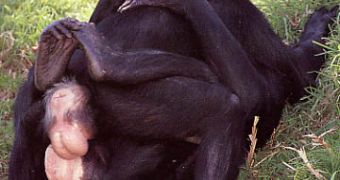Homosexuality is regarded as being unnatural, but that's a paradox: nature abounds in examples of homosexual behavior in animals.
Various explanations have attempted to explain homosexuality in both humans and animals. Some researches point that genes conferring homosexuality in men could deliver more fertile female offspring and the genes that confer high masculinity can produce lesbian female offspring. Vice versa, genes of high femininity can render homosexual male offspring.
One hypothesis suggests that males can sometimes gain support in a pack by having homosexual contact, increasing their chances of copulating females. When a species is mostly bisexual, homosexual relationships allow an easier way to join a pack. Homosexual sex can sometimes train infants for adult sexual roles.
It appears clearly now that for many species, like in humans, mating may not have a necessarily reproductive role. And observations made on our closest relatives, monkeys and apes, could explain the homosexual behavior in humans. This seems to be a basic primate pattern not exclusive to man.
In the case of Bonobo, the dwarf chimpanzee, the closest living species to humans, the community model is based on female solidarity and good relationships between the two sexes. Sex is at the basis of their social relationships and the weakest conflict is solved through sex, no matter if the other is male or female, as part of social bonding. This ape actually mates from each possible position.
From time to time, there are real orgies in the bonobo groups, with individuals of any sex and age (offspring included!) taking part, with both heterosexual and homosexual behavior. Bonobos frequently masturbate and females do it, too, which is very unusual.
The only taboo is sex between mother and son and almost all bonobos are bisexual. They copulate frenetically and often express sexual pleasure by screaming, especially females, in 66 % of the cases. The females form alliances, hardened by lesbian sex, and this way they detain a dominant position inside the group (but a peaceful one).
"In bonobos for instance, strict heterosexual individuals would not be able to make friends in the flock and thus never be able to breed," said Petter Bockman from University of Oslo.
But homosexuality is also common with the Japanese macaques. Here, females form strong bounds with one another and temporary lesbian pairs during the mating season, ruling several partners during the whole period. They stimulate genitally each other and express their pleasure by cackling. That's why the links amongst females are extremely strong in a group.
In each group, there is an older dominant male that will have priority in copulating the females. The other male macaques practice homosexuality, but they do not form pairs, preferring a one-night stand.
In stumptail macaques too there is a frequent prolonged, intensive genital stimulation between individuals of the same sex, both males and females, adults and infants. Homosexual activities were accompanied by positive emotional facial expressions.
During the first copulations of the young they are helped by adults of the same or opposite sex.

 14 DAY TRIAL //
14 DAY TRIAL //